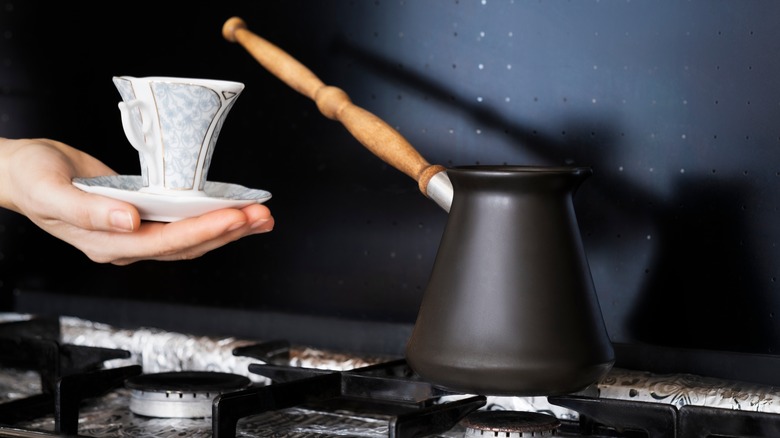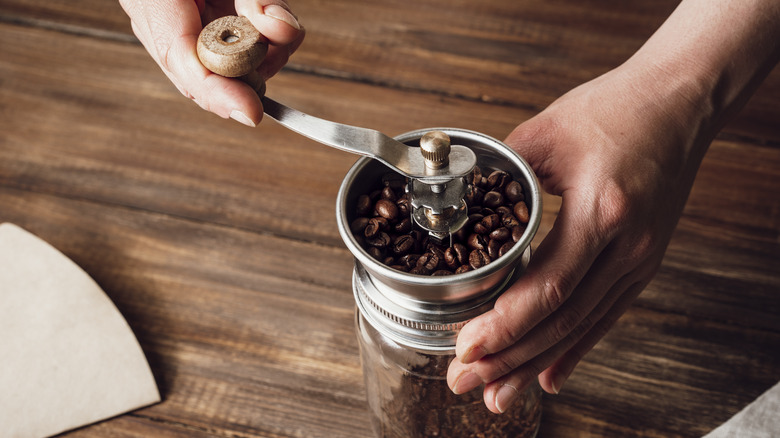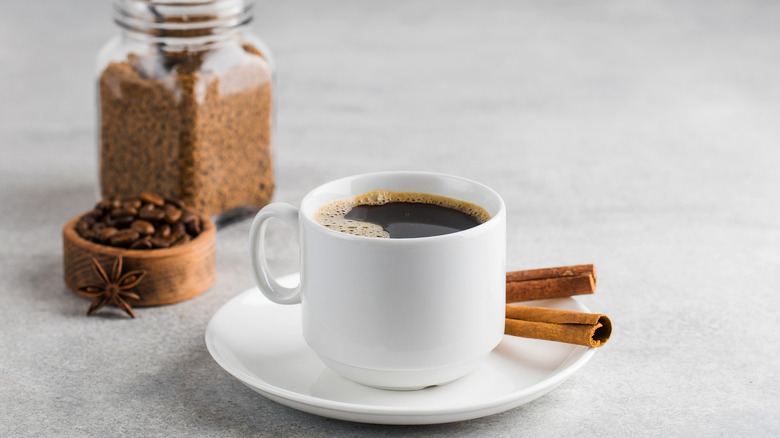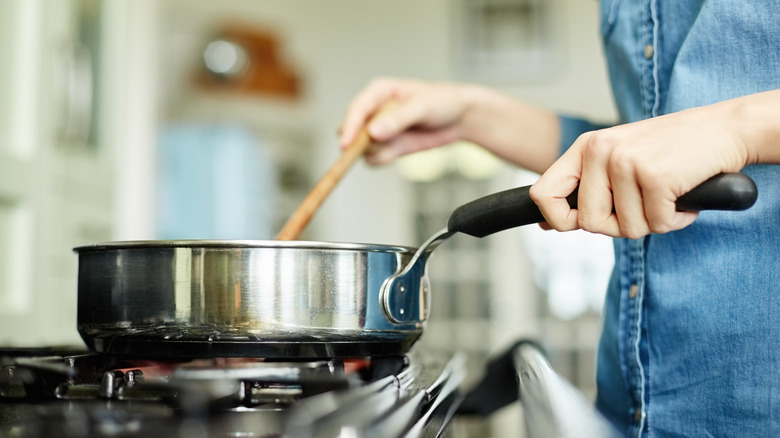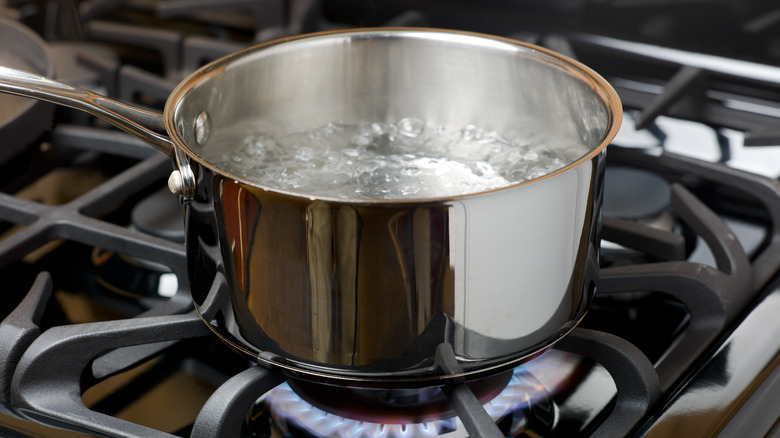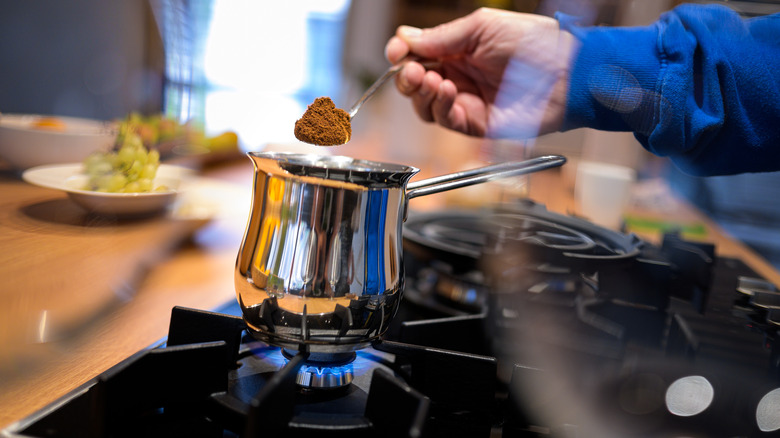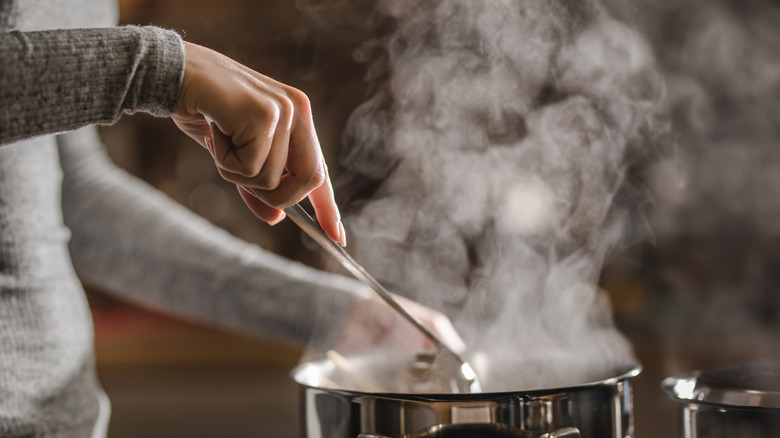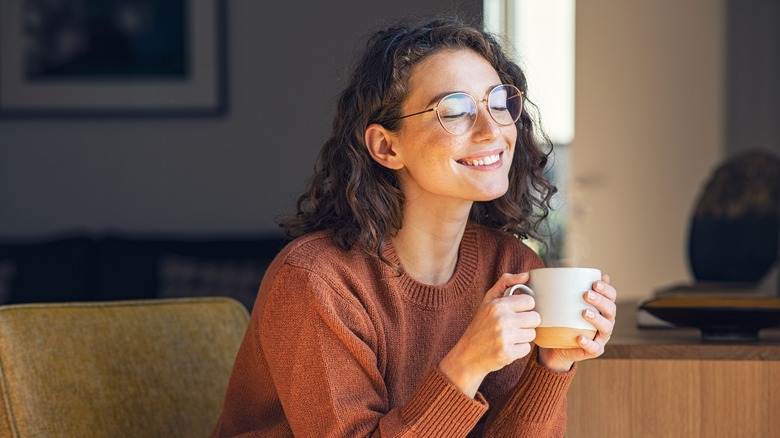How To Brew A Simple Cup Of Coffee On The Stovetop
Coffee makers may be popular, but they aren't the only way to brew your morning cuppa. There are plenty of reasons to reach back to the old ways of making coffee. After all, humans have been drinking coffee since long before appliances were around. You may like the convenience of turning it on, but machines require maintenance and, if you aren't cleaning it right, you're probably getting a funky taste on the back end. There's also the coffee oils to think about. Paper filters enjoy a commanding role in the coffee world, but they filter out the rich coffee oils, making for an arguably subpar drink.
Whatever your reason is for trying it, making coffee on the stove is more than a second-class alternative. It can seem a little intimidating since you don't want the coffee grounds to end up in the mug but, once you know how to do it, you'll think it's funny how afraid you were. It's cowboy coffee from the comforts of your own home.
Before you start brewing
Don't forget to grind up your coffee beans before you start brewing. By grinding the beans, you're increasing the surface area which gives the water more access to your delicious, caffeine-packed beans.
Figure out how much coffee you want to make. For a single serving, 8 to 12 ounces is typical. You'll want to adjust the amount of water up slightly to accommodate for evaporation. So, for a 12-ounce serving, start with 13 ounces of water.
Next, you'll need to decide how strong you want your coffee to be. For a 12-ounce cup of coffee, 2 to 3 tablespoons of coffee grounds is a good baseline. But you can adjust that according to your own tastes.
Adjusting for acidity
If you're sensitive to acidity or have a history of heartburn or acid reflux, you should know that the coffee oils are going to make the coffee more acidic. But luckily, there are a number of ways you can counteract this. The first thing to consider is your water temperature. The hotter your water is when you're brewing, the faster the contents of the coffee beans are going to transfer to it. If you want a less acidic cup of coffee, aim for around 200 degrees Fahrenheit instead of a rolling boil.
If you're struggling with acid, it helps to know what kinds of coffee are more acidic than others. Dark roast coffee is the least acidic, but you can also buy specifically low-acid coffee beans. These beans are roasted in a certain way that reduces acidity without compromising on flavor.
You can also add ingredients to your coffee to decrease acidity. Baking soda is a natural antacid and will raise the pH of your coffee (making it less acidic) and combat heartburn. Simply add a quarter teaspoon of baking soda to your coffee grinds. Cinnamon, in small quantities, is another antacid. It won't affect the pH levels, but it will combat heartburn and add a lovely spiciness to your drink.
Don't forget about dairy. Adding milk or almond milk to your coffee can neutralize the acidity, and brewing coffee with a small amount of ghee is also popular.
What you need to get started
At its most basic, all you'll need is a saucepan, a spoon, coffee beans, water, and a coffee mug to pour it all in. If you have a fine mesh strainer that can fit over your mug, it'll help keep the coffee grounds out and make the process easier, but it's optional. If you have an electric kettle that you use to heat up water, that can speed things up but, again, optional.
Heat the water
Now that you're ready to begin, start by heating the water. If you're using an electric kettle, go ahead and use your device to heat up the water and then pour it into the saucepan over low heat. If you're heating the water on the stove, heat it over high heat.
Although some people like to bring the water to a rolling boil, aiming for 200 degrees Fahrenheit is optimal. You aren't going to get as much of an acidic bite this way, and the beans won't steep too fast.
Add the coffee grounds
If you're used to making coffee with filters, this step is going to feel a little weird, but go ahead and pour the coffee grounds into the water. Think of it as a more rustic version of a French press.
If you use the electric kettle to heat your water, you can add the coffee grounds first. Either way is fine. However, if you're heating the water on the stove, it's crucial that you heat the water first before adding the coffee. Your coffee is going to start brewing the minute the beans touch the water, and you want your water hot before that starts to happen.
If you are adding anything to your coffee, now is the time to do it. Sugar, cinnamon, baking soda; whatever it may be, go ahead and add it now.
Stir and brew
Once the coffee is in the water, go ahead and turn the heat off unless you used the electric kettle. You're going to brew the coffee for four to five minutes. The longer you brew the coffee, the stronger it will be, so it's up to you to decide how strong you want it.
As for stirring, everyone is going to have their preference. Some people stir the entire time the coffee is brewing, some give it a few occasional stirs throughout, and some don't stir at all. Feel free to experiment to discover if you have a preference.
That being said, if this is your first time brewing coffee this way, try stirring occasionally. Take a spoon every couple of minutes and mix the grounds around.
Pour the coffee
Now that your coffee is done brewing, it's time to put it in your coffee mug. As you may have noticed, the coffee grinds are still in the water. A real cowboy may not care about drinking thick coffee and getting grounds stuck in his teeth, but that doesn't mean we have to pretend to enjoy it. The easiest way to keep the coffee grounds out while keeping those flavorful coffee oils in is to get a fine mesh strainer and pour the brew over it and into the mug.
If you don't have a strainer, don't worry. Most of the coffee grounds will have settled to the bottom anyway. If you pour slowly and carefully, you should be able to avoid the grounds coming along for the ride. That said, there may be some floaters that survive the journey.
If that doesn't sound like something you want to do, you can also grab a ladle and transfer it over that way. You'll have a little more control than if you were to just pour it over, giving you a better chance of a clean cup.
